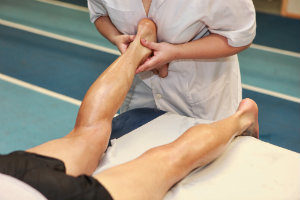Answers to Your Achilles Tendinitis Pain
It is good to set goals and work toward them. However, if you decide to train for a 5K race or start an exercise program to lose weight, avoid one very common mistake: doing too much, too soon. You may not look at the back of your ankle very often, but you’ll become very familiar with it if you develop an overuse injury like Achilles tendinitis!
Why You Have Pain at the Back of Your Heel
The Achilles tendon is connected to your calf muscles and runs down the back of your ankle to insert into the heel bone. It is the strongest tendon in your body and enables you to do things like stand on tiptoe, walk, run, and jump. If the tissue is overused and overstressed, it can become inflamed.
is connected to your calf muscles and runs down the back of your ankle to insert into the heel bone. It is the strongest tendon in your body and enables you to do things like stand on tiptoe, walk, run, and jump. If the tissue is overused and overstressed, it can become inflamed.
This is normal when any part of your body is damaged or diseased: white blood cells are sent to fight off infection, and extra blood accumulates to provide more healing nutrients to the cells. Unfortunately, along with them come swelling, irritation, redness, warmth, and pain. The area affected is either right where the Achilles attaches to the heel bone or the few inches above it behind your ankle.
The inflammation usually subsides in a few days if the tissues are rested and allowed to heal. However, if you keep overusing and stressing them every day without allowing them down time for repair (as you might if you attack your new activities and goals with enthusiasm), the inflammation can become chronic and the tissue can begin to degenerate, causing fiber breakdown and tears in the tissue—and even more pain.
Best Treatments for Achilles Tendinitis
Step 1: Get some rest. Don’t run long distances every day. You need to work up to these gradually by starting small and taking rest days in between. You can try biking or swimming if you still want to work on your cardio, or yoga to help with breathing and flexibility on your off days.
Step 2: Apply some ice. Use a bag of frozen peas or corn and a thin cloth to make an ice pack that molds itself around the back of your ankle. Chilling the painful area can accomplish two goals at once—reducing swelling and relieving pain. Do it for about 20 minutes a time a few times a day.
Step 3: Take some medication. If the pain is severe, we can recommend a pain reliever and dose that should help take the edge off. Certain ones also have an anti-inflammatory effect, but must be used with caution, so contact us for guidelines.
Step 4: Do some stretches. Tight calf muscles can also lead to tendinitis, so a basic stretching routine can help not only treat but also prevent this painful condition. We will show you how to do the best ones to limber up the muscles without further damaging the tendon.
Step 5: Get some help. We will evaluate your tendinitis and help you figure out which type of shoes will better support your feet and head off troubles. With certain foot shapes and arches, custom orthotics may be very helpful, and we may even have you wear a walking boot for a time if the injury is severe. Extracorporeal shockwave therapy (ESWT) is another option for relieving chronic pain, and if even that doesn’t help, we can discuss whether surgery may be the best course forward.
Come to Our Foot Experts in Los Angeles County for Answers
At Far West Podiatric Medical Group, we see a lot of Achilles tendinitis and are always happy when we can relieve your pain and get you back to working on your fitness goals once again. Call our office in Hawthorne, CA at (310) 675-0900 to set up your appointment, or request one online today, and let’s get started!

How Can We Help You?
